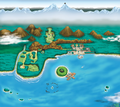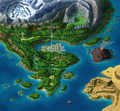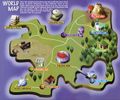Region: Difference between revisions
(→In spin-off games: Reorganizing and restructuring.) |
mNo edit summary |
||
| Line 1: | Line 1: | ||
{{samename|regions used for region-locking|Software | {{samename|regions used for region-locking|Software region}} | ||
[[File:RegionsMoviesMap.jpg|thumb|350px|A map of the Kanto, Johto, Hoenn, and Sinnoh regions, along with the Sevii Islands and the Orange Archipelago, from the {{pkmn|anime}}'s [[M10|10th anniversary]]]] | [[File:RegionsMoviesMap.jpg|thumb|350px|A map of the Kanto, Johto, Hoenn, and Sinnoh regions, along with the Sevii Islands and the Orange Archipelago, from the {{pkmn|anime}}'s [[M10|10th anniversary]]]] | ||
A '''region''' (Japanese: '''{{tt|地方|chihō}}''' ''region'') is an organized area of the [[Pokémon world]]. There are at most sixteen known regions that have appeared in the various Pokémon [[canon]]s. | A '''region''' (Japanese: '''{{tt|地方|chihō}}''' ''region'') is an organized area of the [[Pokémon world]]. There are at most sixteen known regions that have appeared in the various Pokémon [[canon]]s. | ||
Revision as of 07:28, 29 August 2020
- If you were looking for the regions used for region-locking, see Software region.

A region (Japanese: 地方 region) is an organized area of the Pokémon world. There are at most sixteen known regions that have appeared in the various Pokémon canons.
In the core series
Eight regions have appeared in the core series of Pokémon games. They are, in order of appearance, Kanto, Johto, Hoenn, Sinnoh, Unova, Kalos, Alola, and Galar. Each region has been the setting of at least two games in the generation in which it debuts.
Most regions are structured similarly. Typically, a region has its own Pokémon League, which includes eight Gym Leaders. Once these eight are defeated, Pokémon Trainers can challenge the regional Elite Four and Champion (except Johto, which shares the Indigo League with Kanto). Alola does not have Gyms but instead hosts the island challenge and only recently created a Pokémon League. Each region also has a Pokémon Professor who teaches new Trainers about Pokémon and typically gives out starter Pokémon to them. There is usually a villainous team operating within the region that uses Pokémon to further its goals.
Though there are many similarities between them, there are some major differences between the regions, such as what Pokémon are located there and what legends there are waiting to be uncovered. Visitors from another region quickly realize that the region they are visiting is far from their home, both in the way of the climate, distance and location; and in the culture of the people there.
In Diamond, Pearl, and Platinum, Professor Oak explains that Sinnoh, Kanto, and Hoenn (and probably Johto and others) are part of a larger country, whose name has yet to be revealed. This concept is similar to the regions of Japan, which the Pokémon world has been modeled after, and from which the Pokémon nation's Kanto region takes its name. Unova, Kalos, and Alola are known to be located far away from Kanto and Johto, and as such they may not be part of this country.
Art
- LGPE Kanto Map.png
The Crown Tundra in Pokémon Sword and Shield's Expansion Pass
In the side series
The region of the Generation III side series games, Pokémon Colosseum and Pokémon XD: Gale of Darkness, Orre has similar characteristics to the core series regions but lacks some basic core series features. There are mostly Pokémon Trainers inhabiting the region. There are very few settlements and no routes. There is no official Pokémon League, but rather a variety of facilities which offer consecutive battles. There is a regional professor, Professor Krane and regional villains, Cipher and Team Snagem. Wild Pokémon only appear in rare areas called Poké Spots.
Art
In spin-off games
Pokémon Ranger series
In the Pokémon Ranger series, the regions of Fiore, Almia, and Oblivia are much smaller and have different cultures than the core series regions. Pokémon Trainers are not present in the regions. Pokémon are not kept inside Poké Balls and wild Pokémon can be seen wandering cities as well as routes. Pokémon Rangers act as authority, helping Pokémon and people in need. There are no individual Gyms, an Elite Four or a Champion. However, Rangers can take the Capture Challenge to test their skills. Despite their peaceful natures, there are villainous teams that operate within both regions that capture and use Pokémon to further their goals of world domination. One such villainous team has been known to brainwash Pokémon using their advanced technology, causing them to lose their memories and wreak havoc. There is an associated federation similar to the Ranger Union in Fiore and Almia that organizes all activities for rescue and exploration teams.
Pokémon Mystery Dungeon series
The Pokémon Mystery Dungeon series takes place in a world that is populated solely by Pokémon; humans do not live there. The world has six continents, with many Pokémon found in dungeons, but also towns in which Pokémon live, including Pokémon Square, Treasure Town, Post Town, and Lively Town. Some of the Pokémon within them form exploration teams that explore dungeons and help Pokémon in need. The Wigglytuff Guild is where beginning exploration teams live and learn the basics, while the Expedition Society serves a similar role for expedition teams. The Makuhita and Marowak Dojos are places somewhat similar to Gyms in the main regions where exploration teams hone their skills.
Other games
Holon and the Trading Card Game Islands appear in the Pokémon Trading Card Game and the eponymous video games. The relationship of these regions with the others is unclear.
Pokémon Snap is set on Pokémon Island, an isolated reserve home to many species of Pokémon. It appears to have a relationship with the Kanto region of the core series, as Professor Oak appears to have some authority over the island.
Pokémon Channel is set in Mintale Town, which is inhabited by many species of Pokémon. Humans may live there too; there is at least one suburban area.
Pokémon Conquest takes place in the Ransei region, which is said to have been created by Arceus and is divided into 17 kingdoms, each ruled by a different warlord.
Pokkén Tournament takes place in the Ferrum region, which seems to be located somewhere in the core series Pokémon world, as Cinnabar Island is mentioned in the game.
Pokémon Duel takes place on Carmonte Island, an artificial resort island filled with luxury hotels.
Detective Pikachu's main setting is Ryme City, a big city where people and Pokémon live together. It likely has some kind of connections to the core series regions, as Alolans are both mentioned and shown to exist in the game.
Pokémon Quest takes place on Tumblecube Island, which is inhabitited by numerous cube-shaped Pokémon. It seems to have connections to the core series Pokémon world, as the Silph Co. is mentioned at one point.
Pokémon Masters takes place on Pasio, an artificial island built by Lear to host the Pokémon Masters League, in which Trainers from various core series regions compete against each other.
Art
In the anime
The protagonists of the Pokémon anime, Ash Ketchum and his traveling companions, have visited all eight of the core series regions in the same order the games have been released. To accommodate plots, story arcs, and episode numbers, regions in the anime are much larger than their game counterparts. The regions are also shown to have a number of cities and towns that are not present in the games. In some cases, some areas are moved to a different region from their game counterparts; for example, the Hoenn Battle Frontier in Pokémon Emerald was not in Hoenn in the anime, but instead in Kanto with the different facilities scattered all over the region rather being located on an island. Additionally, Pokémon FireRed and LeafGreen's Sevii Islands appeared in one Pokémon Chronicles episode, The Search for the Legend.
Additionally, two regions exist in the anime that do not exist in any video game:
- Orange Archipelago, the tropical setting for the second season, Adventures in the Orange Islands. Located south of Kanto and Johto, it differs from the standard region formula, with only four Gyms.
- Decolore Islands, the setting of the final arc of Pokémon the Series: Black & White. It is located between Kanto and Unova, and it has no Pokémon Professor, no Pokémon Gyms, and no Pokémon League.
Trivia
- Both anime-exclusive regions are archipelagoes.
- Before Generation VIII, each core series region has the letter 'o' present in its English name (Kanto, Johto, Hoenn, Sinnoh, Unova, Kalos, and Alola). The anime-exclusive regions also have the letter present (Orange Archipelago and Decolore Islands).
- Out of all of the regions in-game, Unova has the highest population of 949. Kanto has the lowest, with 391 in Generation III and 364 in Generation IV.
In other languages
| ||||||||||||||||||||||||||||||||||||||||||||||||||||||||||||||||||||||||||||||||
| Regions in the Pokémon world | ||
|---|---|---|

|
This article is part of Project Locations, a Bulbapedia project that aims to write comprehensive articles on every location in the Pokémon world. |


























